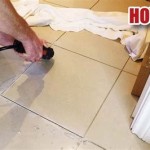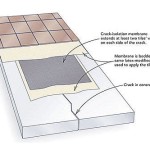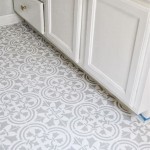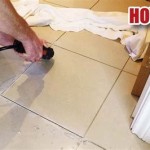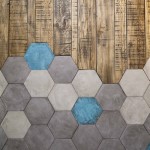Can You Cover Asbestos Tile with Plywood? Weighing the Options and Risks
The question of whether to cover asbestos-containing floor tile with plywood is a common one for homeowners and contractors dealing with older properties. The presence of asbestos, a known carcinogen, adds complexity to any renovation or flooring project. While covering asbestos tile might seem like a simpler and more cost-effective alternative to removal, there are several factors to consider to ensure the safety of building occupants and compliance with applicable regulations. Understanding the potential risks and benefits, as well as the legal and ethical implications, is crucial before proceeding with any course of action.
Asbestos was widely used in building materials, including floor tiles and the associated mastic or adhesive, due to its fire-resistant and durable properties. However, when asbestos-containing materials (ACM) are disturbed, asbestos fibers can become airborne and, if inhaled, can lead to serious health problems, including asbestosis, lung cancer, and mesothelioma. Intact and undisturbed asbestos-containing floor tiles generally do not pose a significant health risk. The danger arises when these tiles are damaged, broken, or sanded, releasing asbestos fibers into the air.
Therefore, the decision to cover asbestos tile with plywood hinges on the condition of the existing tiles, the intended use of the space, and adherence to local, state, and federal regulations regarding asbestos management. It’s essential to approach this situation with a thorough understanding of the associated risks and legal requirements.
Assessing the Condition of the Asbestos Tile
The first step in determining whether covering asbestos tile is a viable option is to carefully assess the condition of the existing flooring. If the tiles are in good condition, meaning they are intact, undamaged, and securely adhered to the subfloor, the risk of fiber release is minimal. In this scenario, covering the tiles might be considered a reasonable approach.
However, if the tiles are cracked, broken, loose, or show signs of deterioration, covering them without proper precautions is not advisable. Damaged tiles are more likely to release asbestos fibers, and any further disturbance during the installation of plywood could exacerbate the problem. Areas with water damage or evidence of previous attempts to remove or repair the tiles should be treated with extreme caution.
A professional asbestos inspection and testing should be considered to accurately determine the asbestos content and condition of the tiles. A certified asbestos inspector can assess the extent of the problem and provide recommendations based on the specific circumstances of the situation. This assessment will help in making an informed decision about the most appropriate course of action.
It's critical to document the condition of the existing tiles before any work begins. This documentation should include photographs and detailed notes describing any damage, loose tiles, or other potential sources of asbestos fiber release. This documentation can be helpful in demonstrating due diligence and ensuring compliance with regulations.
The Process of Covering Asbestos Tile with Plywood
If, after careful assessment and professional consultation, covering the asbestos tile is deemed an acceptable option, it is crucial to follow specific procedures to minimize the risk of asbestos fiber release. These procedures should be implemented to contain any potential asbestos fibers and prevent them from becoming airborne and inhaled.
Prior to installing the plywood, it's generally recommended to encapsulate the existing asbestos tile with a sealant. This sealant acts as a barrier, helping to prevent any fibers from being released during the plywood installation process. The sealant should be applied according to the manufacturer's instructions and allowed to dry completely before proceeding.
Careful consideration should be given to the method of securing the plywood to the subfloor. The use of nails or screws should be minimized to avoid penetrating the asbestos tile and potentially releasing fibers. Adhesives specifically designed for bonding plywood to existing flooring are often a better option. When using fasteners, ensure they are of the appropriate length to avoid damaging underlying utilities.
During the installation process, it's essential to maintain a clean workspace. The area should be well-ventilated and equipped with appropriate dust control measures, such as HEPA-filtered vacuums. Any debris generated during the installation should be carefully collected and disposed of according to local, state, and federal regulations for asbestos-containing materials.
Consider the addition of a layer of underlayment between the asbestos tile and the plywood. This can provide an additional layer of protection and help to create a smoother, more even surface for the new flooring. The underlayment should be chosen based on the type of flooring that will be installed on top of the plywood. The thickness and material of the underlayment can impact the overall performance and comfort of the finished floor.
Legal and Ethical Considerations
Beyond the practical aspects of covering asbestos tile with plywood, it's imperative to consider the legal and ethical implications of this approach. Asbestos is a regulated material, and there are specific laws and regulations governing its handling, removal, and disposal. Failure to comply with these regulations can result in significant fines and legal penalties.
Before undertaking any work involving asbestos-containing materials, it's crucial to consult with local, state, and federal authorities to understand the specific requirements in your area. These requirements may vary depending on the type of building, the amount of asbestos present, and the nature of the work being performed. Some jurisdictions may require permits or licenses for asbestos-related work, even if it involves encapsulation rather than removal.
Disclosure is also an important ethical consideration. If you are selling or renting a property with asbestos-containing flooring, you may be legally obligated to disclose this information to potential buyers or tenants. Failure to disclose the presence of asbestos could result in legal action. It is always best to be transparent about the presence of asbestos and to provide information about any steps that have been taken to manage the risk.
Even if covering the asbestos tile is legally permissible, it's important to consider the potential impact on future renovations or demolition work. Someone unaware of the underlying asbestos could inadvertently disturb the tiles, creating a hazardous situation. Clear labeling or documentation indicating the presence of asbestos beneath the plywood is recommended to prevent future accidental exposure.
Consider the long-term implications of choosing to cover the asbestos tiles instead of removing them. While covering may provide a temporary solution, it does not eliminate the underlying problem. Future repairs or renovations may require disturbing the asbestos-containing materials, potentially exposing workers and building occupants to asbestos fibers. In some cases, removal may be the most responsible and cost-effective option in the long run, offering a permanent solution and eliminating any future risk of exposure.
The decision to cover asbestos tile with plywood should not be taken lightly. It requires careful assessment, adherence to proper procedures, and a thorough understanding of the legal and ethical considerations involved. Consulting with qualified professionals, including asbestos inspectors and abatement contractors, is essential to ensure that the work is performed safely and in compliance with all applicable regulations. Prioritizing the health and safety of building occupants is paramount in any asbestos-related project.

How To Seal Asbestos Tiles Hunker

Marmoleum Over Possibly Asbestos Containing Vinyl Tile

Let S Play A Game Called Are These Asbestos Tiles That I Just Removed Addicted 2 Decorating

Powder Room Floor Marmoleum Over Asbestos Tile

Tile Subfloor Deflection Thickness Common Substrates

Asbestos Tile What Did You Do With Yours

Asbestos Diy Home Improvement Forum

Is This Asbestos Mold Rot Anyone Have An Idea Hometalk

Vinyl Asbestos Tile

Can I Put A New Floor Over Asbestos Tiles Branch Environmental
Related Posts


